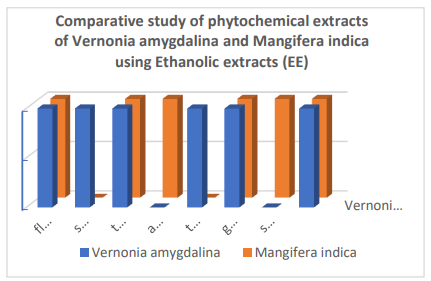Comparative Study of Phytochemicals Composition of Mangifera Indica (Mango) and Vernonia Amygdalina (Bitter Leaf) Leaves and Their Antimicrobial Activities
Keywords:
Phytochemicals, antimicrobial activities,, solvent extraction, bactericidal concentration, percolation, leavesAbstract
Mangifera indica and Vernonia amygdalina leaves are utilized for the treatment of various illnesses in folklore medicine. This research aimed to look at the antimicrobial effects and phytochemical compositions of leaf extracts of two studied plants obtained within the Katsina metropolis using different solvent extraction techniques (ethanolic and aqueous extraction) and their antimicrobial activities. The powdered leaves of the examined plants were extracted with water and ethanol solvents using the percolation method. Phytochemical studies were conducted following standard protocols to detect secondary metabolites. Phytochemical screening revealed the presence of several compounds including alkaloids, flavonoids, saponins, glycosides, steroids, terpenoids, tannins, and phenols. This work showed that the two different solvent extraction methods (ethanolic and aqueous) have varying abilities to liberate active compounds, and the presence of these secondary metabolites in the selected plants has high healing potential. Thus, these phytochemicals enhance the medicinal value of the studied plants. The current data also showed that the two extracts (Mangifera indica and Vernonia) had a range of antimicrobial effects on the different strains that were tested. The microorganisms that were tested were sensitive to different amounts of Staphylococcus aureus, Salmonella typhi, and Pseudomonas aeruginosa. The highest zone of inhibition was observed in Vernonia amygdalina ethanolic extract with 18.0mm (250mg/ml) for Staphylococcus followed by ethanolic extract against Salmonella typhi with 16.0mm (250mg/ml). The lowest concentration of 31.25 mg/ml had minimal or no effect on the test bacteria. The findings of the Minimum Inhibitory Concentration (MIC) and Minimum Bactericidal Concentration (MBC) against bacterial isolates showed that Vernonia amygdalina exhibited the lowest minimum inhibitory concentration (MIC) values compared to the other extracts while the extracts of Vernonia amygdalina also exhibited the lowest minimum bactericidal concentration (MBC) values.
References
Abosi, A.O. and B.H. Raseroka, “in vivo antimalarial activity of V. amygdalina”. Br. J. Sci. Vol.60, Issue.2, pp.89-9, 2003.
Adenuga W, Olaleye ON, Adepoju P.A. “Utilization of bitter vegetable leaves (Gongronema latifolium, Vernonia amygdalina) and Garcinia kola extracts as substitutes for hops in sorghum beer production”. Afri J Biotechnol, 9: pp.8819-8823, 2010.
Aliyu, B. S. “Some ethno-medicinal plants of the Savannah Regions of West Africa Description and phytochemicals.” Triumph publishing company. pp.135–152, 2006.
Bibitha B,Jisha V.K,Salitha C.V, Mohan S and Valsa A.K “Antibacterial activity of different plant extracts. Short communication”. Indian J. Microbiol. 42, pp.361-363, 2002.
Bouayed, J., Ramma, I.H., Dicko, A., Younos, C. and Soulimani, R. “Chlorogenic Acid, a Polyphenol from Prunusdomestica, with Coupled Anxiolytic and Antioxidant Effect”. J Neurol Sci, 262: pp.77-84, 2007.
Dweck, A.C. “Article for cosmetics and toiletries magazine ethnobotanical plants from Africa”. Black Medicare Ltd, Itshire, UK. 22: pp.27-84, 2011
Erinle, O.D. “Phytochemical Screening of Scent leaf (Ocimum gratissimum) and bitter leaf (Vernonia amygdalina) extracts”. ND Project, FCFFT, New Bussa, Niger State pp.1-5. 2012
Fatope, A., O., Ibrahim, H. and Takeda, Y. “Screening of higher plants reputed as pesticides using brine shrimp lethality bioassay” International Journal of Pharmacognosy, 31, pp.250-256, 1993
Harborne J. B. “Phytochemical Methods”. London, Chapman and Hall. Ltd, pp.49-188, 1973.
Harborne, J. B. and Williams, C.A. “Advances inflavonoid researches since 1992”. Phytochemistry Journal; 55, pp.481-504, 2000.
Jayanti Ghuniyal “Ethnomedical, Chemical, Pharmacological, Toxicological Properties of Mangifera indica: A Review” International Journal of Pharma Research & Review, Oct 2015; Vol.4, Issue.10, pp.51-64, 2015
Odunbaku, O. A. and Ashidi, J.S. “Antimicrobial effect of ethanol leaf extracts of selected medicinal plants on some human pathogenic microbes.” International Journal of Science and Advanced Technology; 2:8, 2012.
Oladosu-Ajayi R. N, Dienye H. E, Ajayi C T, Agha I. U “Vernonia amygdalina [Bitter leaf] extracts as preservative for catfish, Clarias gariepinus” International Journal of Nutritional Science and Food Technology, 3, pp.2471-7371, 2016
Sandhya, B., Thomas, S., Isabel, W. and Shenbagarathai, R. “Ethnomedicinal plants used by the Valaiyan community of Piranmalai hills (reserved forest).” Journal of Complementary and alternative medicines, 3, pp.101-114, 2016
Shanjida, I., T., Hossain, M. I. and Tasneema, I. “Antimicrobial activities of Psidium guajava, Carica papaya and Mangifera indica against some gram-positive and gram-negative bacteria.” Journal of Pharmacognosy and Phytochemistry, 3(6): pp.125-129, 2015
Singh Shashi Kant “Phytochemical and pharmacological investigations on mangiferin” Herba, 55(1), pp.127-139, 2009
Swee, K., Y. Wan, B. Ho, K.H. Boo, S.L. Woon, K. Huyunh, H. Abdul, Y. Naoman and B.A. Noorjaham, “V. amygdalina: an ethnoveterinary used green vegetables with multiple bioactivities.” J. Med. Plant Res, 4(25), pp.2787-2812. 2010
Wauters, G., Charlier, J. and Janssens, M. “Agglutination of pYV + Yersinia enterocolitica strains by agglutinin from Mangifera indica.” Journal of Clinical Microbiology, 33, pp.772–774, 2001.

Downloads
Published
How to Cite
Issue
Section
License

This work is licensed under a Creative Commons Attribution 4.0 International License.
Authors contributing to this journal agree to publish their articles under the Creative Commons Attribution 4.0 International License, allowing third parties to share their work (copy, distribute, transmit) and to adapt it, under the condition that the authors are given credit and that in the event of reuse or distribution, the terms of this license are made clear.





